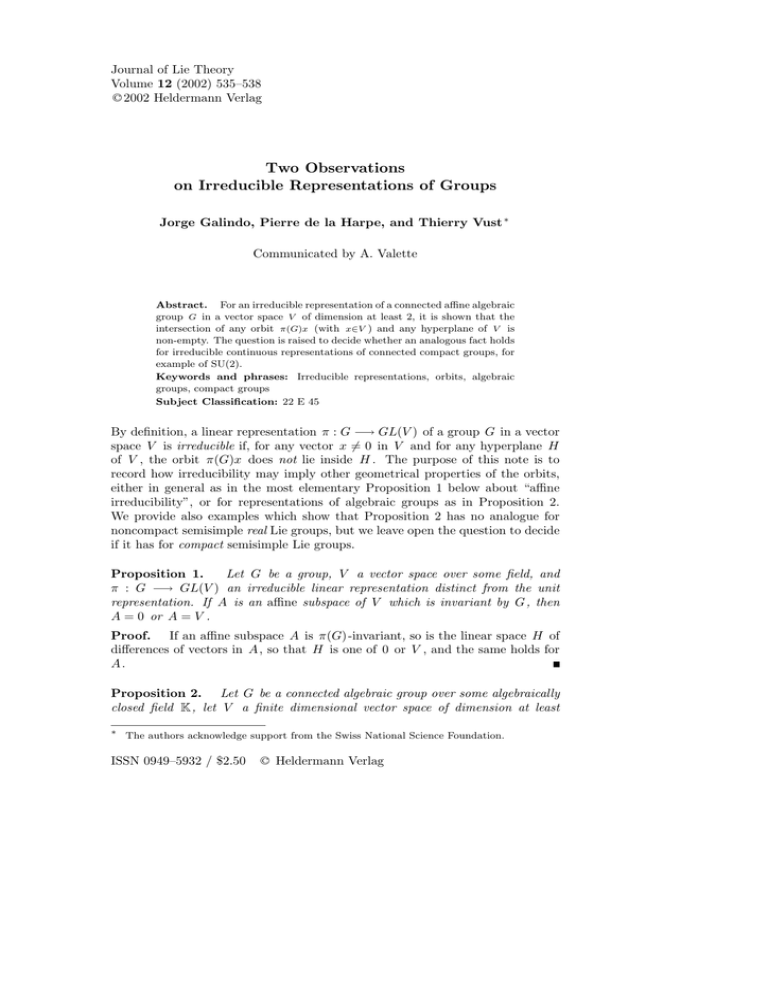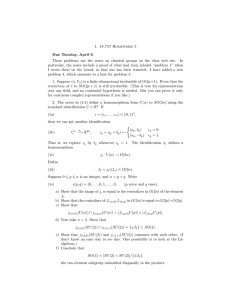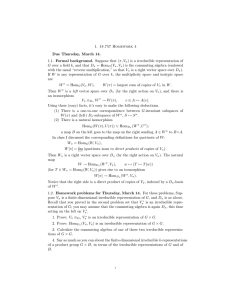Document 10552484
advertisement

Journal of Lie Theory
Volume 12 (2002) 535–538
C 2002 Heldermann Verlag
Two Observations
on Irreducible Representations of Groups
Jorge Galindo, Pierre de la Harpe, and Thierry Vust ∗
Communicated by A. Valette
Abstract. For an irreducible representation of a connected affine algebraic
group G in a vector space V of dimension at least 2, it is shown that the
intersection of any orbit π(G)x (with x∈V ) and any hyperplane of V is
non-empty. The question is raised to decide whether an analogous fact holds
for irreducible continuous representations of connected compact groups, for
example of SU(2).
Keywords and phrases: Irreducible representations, orbits, algebraic
groups, compact groups
Subject Classification: 22 E 45
By definition, a linear representation π : G −→ GL(V ) of a group G in a vector
space V is irreducible if, for any vector x 6= 0 in V and for any hyperplane H
of V , the orbit π(G)x does not lie inside H . The purpose of this note is to
record how irreducibility may imply other geometrical properties of the orbits,
either in general as in the most elementary Proposition 1 below about “affine
irreducibility”, or for representations of algebraic groups as in Proposition 2.
We provide also examples which show that Proposition 2 has no analogue for
noncompact semisimple real Lie groups, but we leave open the question to decide
if it has for compact semisimple Lie groups.
Proposition 1.
Let G be a group, V a vector space over some field, and
π : G −→ GL(V ) an irreducible linear representation distinct from the unit
representation. If A is an affine subspace of V which is invariant by G , then
A = 0 or A = V .
Proof. If an affine subspace A is π(G) -invariant, so is the linear space H of
differences of vectors in A, so that H is one of 0 or V , and the same holds for
A.
Proposition 2. Let G be a connected algebraic group over some algebraically
closed field K, let V a finite dimensional vector space of dimension at least
∗
The authors acknowledge support from the Swiss National Science Foundation.
ISSN 0949–5932 / $2.50
C
Heldermann Verlag
536
Galindo, de la Harpe and Vust
two, and let π : G −→ GL(V ) be a rational irreducible representation. For any
linear hyperplane H of V and any x ∈ V , the intersection of H with the orbit
X = π(G)x is non empty.
Proof.
Consider first the case of a group G which is semisimple. Choose
a linear form f 6= 0 on V such that H = ker(f ) . Define a regular function
φ : G −→ K by φ(g) = f (π(g)x) .
Assume (ab absurdo) that the intersection of H and X is empty. Then
φ does not have any zero on G . A theorem of Rosenlicht (see below) implies that
there exists a constant c 6= 0 such that cφ is a group homomorphism G −→ K∗ ;
this implies that φ is constant since G is perfect. Thus X is contained in an
affine hyperplane of V . The affine hull of X is non-trivial and invariant by
G ; this is absurd by Proposition 1, so that the proposition is proved in the
semisimple case.
Consider now the general case. Let Ru denote the unipotent radical
of G . By a theorem of Kolchin (see e.g. 4.8 in [1]), the subspace V u = {v ∈
V | π(r)v = v for all r ∈ Ru } is not reduced to zero. This space being π(G) invariant, because Ru is normal in G , and π being irreducible, we have V u = V .
Consequently, we may replace G by G/Ru , namely we may assume that G is
reductive.
Let T denote the solvable radical of G , which is a torus (11.21 in [1]).
Let V = ⊕V χ denote the weight space decomposition of the restriction π|T ,
where V χ = {v ∈ V | π(t)v = χ(t)v for all t ∈ T } for χ ∈ Hom(T, K∗ ) . We may
choose ψ ∈ Hom(T, K∗ ) such that V ψ 6= {0}. Since T is normal in G and since
the abelian group Hom(T, K∗ ) is finitely generated (8.2 in [1]), there is a natural
action of the connected group G on Hom(T, K∗ ) and this action is trivial. Hence
V ψ is π(G) -invariant, and indeed is equal to V by irreducibility of π . Thus π
coincides on T with some ψ ∈ Hom(T, K∗ ) .
Now G is a product of its derived group DG and of T , and DG is
semisimple (14.2 in [1]). Thus the equality π|T = ψ ⊗ idV and the irreducibility
of π imply that the restriction of π to the semisimple group DG is irreducible.
This ends the proof of the reduction of the general case to the semisimple case.
Reminder of Rosenlicht’s result [6]. If Y, Z are two irreducible affine algebraic
varieties, any scalar-valued function on the product Y × Z which is regular and
without zero is a product of a regular function on Y by a regular function on Z .
Thus, if φ is a regular function without zero on a linear algebraic group G , there
exist regular functions ψ, χ such that φ(gh) = ψ(g)χ(h) for all g, h ∈ G . Set
c = φ(1)−1 and let ϕ denote the function cφ; the previous relation implies that
ϕ = ψ(1)−1 ψ = χ(1)−1 χ and that ϕ(gh) = ϕ(g)ϕ(h) for all g, h ∈ G , namely
that ϕ is a character on G , by which we mean here a homomorphism of groups
G −→ K∗ . For an exposition of Rosenlicht’s result, see [4]; see also [2].
Corollary. Let G be a reductive connected complex Lie group, let V a finite
dimensional complex vector space of dimension at least two, and let π : G −→
GL(V ) be an irreducible holomorphic representation. For any linear hyperplane
H of V and any x ∈ V , the intersection of H with the orbit X = π(G)x is non
empty.
Proof.
This is a straightforward consequence of Proposition 2, since a con-
Galindo, de la Harpe and Vust
537
nected reductive complex Lie group G has a unique algebraic structure, and
a holomorphic representation of such a group is necessarily algebraic. See e.g.
Theorem 6.4 of Chapter 1 and Theorem 2.8 of Chapter 4 in [5].
Observations. There are no analogues of Proposition 2 for finite groups and
for simple connected real Lie groups, as the following examples show.
(i) If G is a finite group, G -orbits in V \ {0} and hyperplanes are
generically disjoint.
(ii) Let π be the 2 -dimensional irreducible representation of the group
SL2 (R) in the space C2 . For a vector x ∈ R2 , x 6= 0, and the linear span H of
the vector (1, i) ∈ C2 , the SL2 (R) -orbit of x and the hyperplane H are disjoint.
For another example, consider the 3-dimensional irreducible representation of SL2 (R) in the space V of homogeneous polynomials of degree 2 with
complex coefficients in 2 variables ξ, η . If x ∈ V is the polynomial ξη , its
SL2 (R) -orbit X is a surface of equation ρ2 − 4στ = 1 (with respect to appropriate coordinates (ρ,
√ σ, τ ) on V ), and its intersection with the complex hyperplane
of equation σ = i τ is empty.
(iii) Consider more generally an integer n ≥ 2 , the connected component
G of the group SO(n, 1) , and the natural irreducible representation π of G in
Cn+1 . For a non-zero vector x ∈ Rn+1 inside and a real hyperplane H0 ⊂ Rn+1
outside the light cone, it is clear that the orbit π(G)x is disjoint from H0 ; it
follows that π(G)x is also disjoint from the complexified hyperplane H0 ⊗R C in
Cn+1 .
Question. In which situations does some Proposition 2 hold? what about a
connected compact group and an irreducible continuous representation? what
about the irreducible representation of SU (n) ? of SU (2) ? We spell out explicitely the last particular case of the question:
Let πk be the natural representation of SU (2) in the space Pk of
complex polynomials in two variables which are homogeneous of degree k , for
some k ≥ 1 , let H be a complex hyperplane in Pk and let P ∈ Pk ; is it always
true that πk (SU (2))P ∩ H 6= Ø?
Remarks. (i) Let G be a compact topological group, V an Hermitian space,
and π : G −→ U (V ) an irreducible continuous unitary representation distinct
from the unit representation. It is known [3] that, for any vector x ∈ V of
norm √
1 , the diameter maxg∈G kπ(g)x − xk of the orbit π(G)x is strictly larger
than 2 .
(ii) Let G be a compact connected topological group, V a finite dimensional real vector space, π : G −→ GL(V ) an irreducible continuous representation distinct from the unit representation, X = π(G)x the G -orbit of a vector
x 6= 0 in V , and H an hyperplane of V , say H = ker(f ) for some linear form
f 6= 0 on V . Then the intersection of H and X is non empty.
Indeed, define as above φ : G −→ R by φ(g) = f (π(g)x) . If RX ∩ H = Ø ,
then φ is either strictly
positive or strictly negative on G , so that G φ(g)dg =
R
f (y) 6= 0 for y = G π(g)x dg , and in particular y 6= 0 ; but this is impossible
because y is π(G) -invariant by invariance of the Haar measure dg on G .
538
Galindo, de la Harpe and Vust
We are grateful to Gus Lehrer and Alain Valette for useful comments on
the observations of the present Note.
References
[1]
[2]
[3]
[4]
[5]
[6]
Borel, A. “Linear algebraic groups”, second enlarged edition, SpringerVerlag New York etc., 1991.
Broughton, S. A., A note on characters of algebraic groups, Proc. Amer.
Math. Soc. 89 (1983), 39–40.
Deutsch, A. and A. Valette, On diameters of orbits of compact groups in
unitary representations, J. Austral. Math. Soc. Ser. A 59 (1995), 308–
312.
Knop, F., H. Kraft, and T. Vust, The Picard group of a G -variety, in:
H. Kraft, P. Slodowy, and T.A. Springer, Editors, ,,Algebraische Transformationsgruppen und Invariantentheorie“, DMV Sem. 13, Birkhäuser,
Basel, 1989, 77–87.
Gorbatsevich, V. V., A. L. Onishchik, and E. B. Vinberg, “Structure
of Lie groups and Lie algebras,” Lie groups and Lie algebras III, Encyclopaedia of Math. Sciences, Vol. 41, Springer-Verlag Berlin etc., 1994.
Rosenlicht, M., Toroidal algebraic groups, Proc. Amer. Math. Soc. 12
(1961), 984–988.
Jorge Galindo
Departamento de Matemáticas
Universidad Jaume I
8029-AP, Castellón
Spain
jgalindo@mat.uji.es
Pierre de la Harpe
Section de Mathématiques
Université de Genève
C.P. 240, CH-1211 Genève 24
Switzerland
Pierre.delaHarpe@math.unige.ch
Thierry Vust
Section de Mathématiques
Université de Genève
C.P. 240, CH-1211 Genève 24
Switzerland
Thierry.Vust@math.unige.ch
Received July 1, 2001
and in final form September 9, 2001






